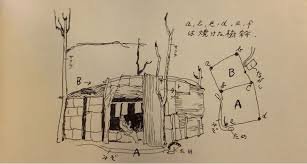Last week’s post ended with the assertion that ‘when it comes to insulation, the best window is no window at all.’ I didn’t mean to suggest that we should forego windows entirely in our houses - of course, habitable rooms need windows, and they are a regulatory requirement. But this is a false binary. What I meant is that windows can and should be consciously sized so as to achieve the best trade-off between light and heat. I put this in italics because the question ‘How much of the wall needs to be window?’ should always be asked, but more often than not isn’t; and the calculation itself is almost never made. Instead, ‘go big and go double glazed’ is the default mantra. Here I would like to demonstrate, via a calculated example, the effect window size can have on the overall rate of heat transfer of the wall it sits in, and the room it serves.
For our example, imagine a room that’s 3m square (room area 9m2) with a 2.4m ceiling. Only one wall is an external wall (with a total area of 3m x 2.4m = 7.2m²), and it contains one window. Assume that the outside temperature is 5°C and the indoor temperature 25°C, for a difference of 20°C.
Next let’s establish a single-paned and double-paned window option for the room. I looked on the WERS website and chose a manufacturer (Capral) at random, then took the worst-performing of each of their aluminium framed fixed single and double-glazed windows: 6mm clear single glazed with a U-value of 6.3, and 6mm clear/12mm air gap/6mm clear double glazed with a U-value of 3.4. Remember that the R-value is the reciprocal of the U-value, so to obtain the R-value simply divide the U-value into 1. So for the single glazed window, 1/6.3 = R0.16; for the double glazed window, 1/3.4 = R0.29.
Given these values, the single glazed window is transferring heat at the rate of 20°C/R0.16 = 125W/ m²; the double glazed window, 20°C/R0.29 = 69W/m².
Let’s also assume that our windows are 1.5 metre wide by 1.5 metres high, i.e. 2.25m² in area. So the total heat transfer of the single glazed window is 125W/m² x 2.25m² = 281.25W, and that of the double glazed window is 69W/ m² 2.25m² = 155.25W.
What area would we need to reduce the single-glazed window to in order to reduce its total heat transfer to that of the double glazed window, i.e. 155.25W? The answer is obtained by 155.25W/125W/m² = 1.24m², for example a window roughly 0.9m x 1.4m. For a 9m² room, this window clears the minimum natural lighting required by the Building Code of Australia, being 10% of the room area, or in this case 0.9m².
In our example using the windows given, it can be seen that reducing a window’s size by around 45% has the same effect as double glazing it. A shortcut way of calculating this equivalence is to simply take the difference between the two U values (6.3 - 3.4 = 2.9) and dividing the single glazed U-value (3.4) into this (2.9/3.4 x 100 = around 45%).
Note that this example hasn’t taken into account the effect of the increase in area of the wall that accompanies the reduction in window size, because for any reasonably-well insulated wall, the effect is negligible in comparison to the effect of the change in window area. But the calculation is worth doing anyway, if only to demonstrate just how terrible the insulative performance of even double glazed windows are when compared to even a moderately insulated wall!
For a 2.25m² double glazed window, there is 7.2m² - 2.25m² = 4.95m² of wall area. Assume a wall with an R value of 4.0, which transfers heat at a rate of 20°C/R4.0 = 5W/ m². The total heat transfer of the wall is 5W/ m² x 4.95m² = 24.75m². Add to this the 155.25W total heat transfer of the window, and we obtain a figure of 180W for the wall and double glazed window together. For the single-glazed example, we have 7.2m² - 1.24m² = 5.96m² of wall area, for 5W/ m² x 5.96m² = 29.80m². Add to this the 155.25W total heat transfer of the window, and we obtain a figure of 185.05W for the wall and glazed window together.
In conclusion, I hope that this and the previous two posts in this series have been persuasive in making the case that double-glazing shouldn’t necessarily be an automatic choice, and that its advantages should be weighed against other considerations such as cost, lifespan, and a more realistic appraisal of the need for natural light; also, I hope I have demonstrated that single-glazing is by no means obsolete but is very much still a viable option in many, and perhaps even most, cases.





